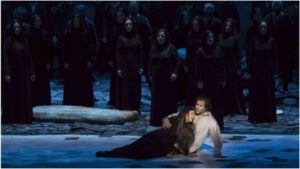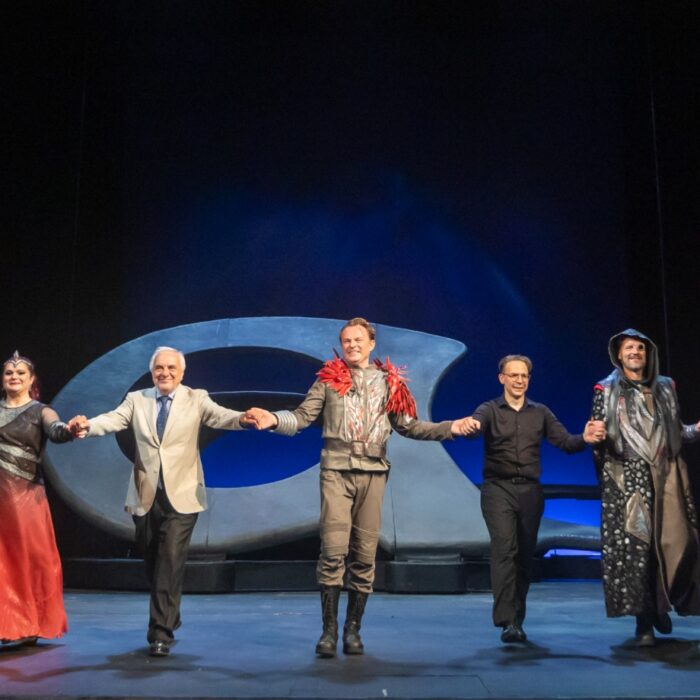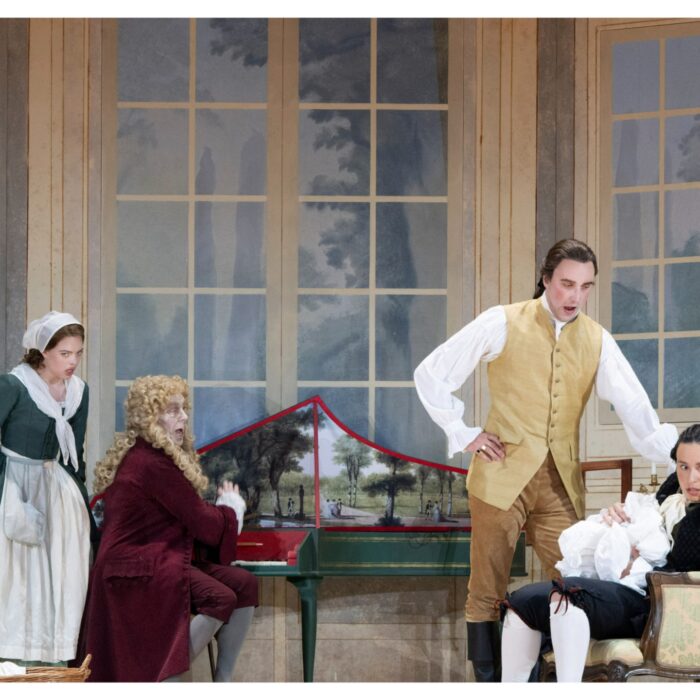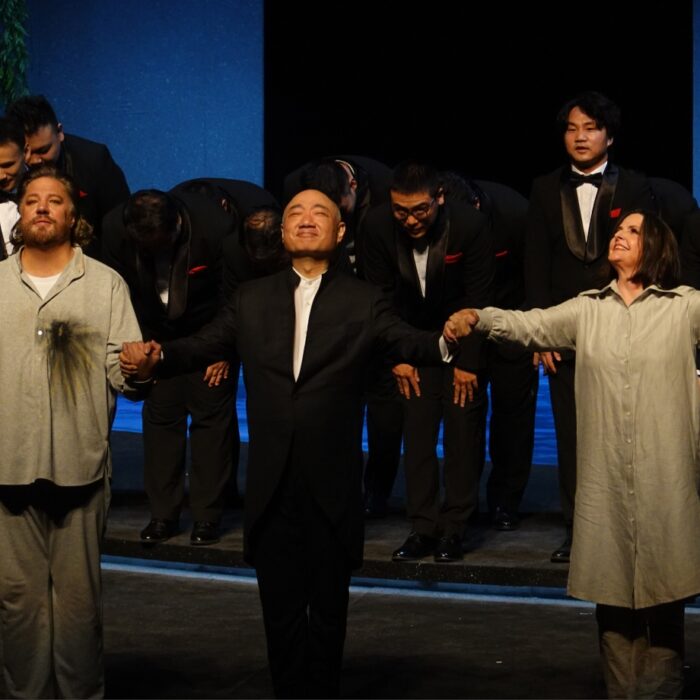
Palau de les Arts 2017-18 Review – Il Corsaro: Michael Fabiano & Vito Priante Dominate in Early Verdi Opera
By David SalazarThis review is for the performance on April 1, 2018.
Many of Verdi’s early operas are strange concoctions. As you sit there listening to these works, you find yourself often carried away by the hints of the genius to come. The knowledge of what he will become creates the anticipation that he will show up in his full greatness in the work at hand, meaning that frustration will eventually set in when these expectations do not come to fruition.
A Frustrating Work
This is the case with “Il Corsaro,” which was presented in a unique production at the Palau de les Arts in Valencia. Verdi’s 13th work contains music that in retrospect points toward later, better works. Corrado’s famous cabaletta “Sì, de’Corsari il fulmini” is the predecessor to “Di quella pira,” so much so, that both arias end with a cry of “All’armi.” Seid and Gulnara’s duet has shades of “Il Trovatore” as well. The list goes on and on throughout the opera.
That said, it does a have a unique feature – two sopranos in major roles, combining for a unique trio to end the opera.
The opera is also a bit of a difficult project in the modern era, given its stereotypical portrayal of Muslim culture. Pasha Seid has many women, but when the one he lusts for, Gulnara, “betrays” him, he turns tyrannical. The libretto hints at the possibility for complexity in his characterization, but its brevity means that ultimately, he never comes off as more than an angry villain.
Any traditional staging would have to deal with this issue, knowing full-well that there isn’t much way around offending an entire culture.
Enter director Nicola Raab, who does something unique, though not all that revolutionary.
Enter Corrado-Byron
The original source material for the opera was by Lord Byron. According to the program notes, Corrado is Byron in the process of writing his work. So for the purposes of this review, we will call him Corrado-Byron.
A massive screen projects wild images that are in-line with one would expect of the traditional approach to the opera. Corrado-Byron moves about in a daze trying to figure out how to make sense of any of it. He rushes to a desk at stage left to write down some ideas. Moments later, he is confronted by his muse in the form of Corrado’s lover Medora. Later, as he goes to sleep, he dreams up Gulnara and Seid. Eventually, he becomes part of the drama and is lost in it. Video projections showcase a massive fire that we later see was not fiction, but fact. In the third act, Corrado-Byron’s apartment is burnt to a crisp and we learn that Gulnara was not a dream, but a real person fictionalized within the Eastern setting.
It’s all interesting and as expected, Raab wants the creator to be lost in his work; by the end of the entire production, so is the audience. Honestly, it’s not the most original approach and it ultimately represents a sidestep of sorts to the issue discussed earlier – Seid is still portrayed in stereotypical fashion, even to an exaggerated extent.
Ultimately, it does allow the opera to be presented without insulting anyone, and that is a good thing.
And this is a positive because it allows for an opportunity for audiences to hear some magnificent singing.
Not All There
As noted, the unique feature of this work is the opportunity to see two sopranos of different ilk singing, essentially, side by side. Medora is more of a lyric style voice while Gulnara is a continuation of Abigaile from “Nabucco” and Lady Macbeth from “Macbeth.”
On this night the sopranos could not be anymore different from one another.
As Medora, was the youthful Kristina Mkhitaryan, a recent top prize winner of the Operalia Competition. In her 20s, she has a beautiful voice with a solid technique to give it life. Verdi demands a ton from the soprano, pushing her from lyrical territory into the borders of the spinto world constantly and the soprano handled it all quite well. She has the entire technical package.
But her singing in the early going seemed to live in the same sound world, the color palette generally minimal; as a result, it was difficult to get a handle on what exactly her take on Medora was. She might be an abstraction for Corrado-Byron, but her interpretation gave off a colder reading of the character. She was far more nuanced in the final act, her voice dipping into softer and more muted colors during the death scene. Yet ultimately, it felt like an incomplete interpretation. This is often the challenge with newer interpretations. This being the second performance, she could still improve significantly throughout the remainder of the run.
As was the case with Mkhitaryan’s interpretation, Oksana Dyka’s Gulnara was far from the ideal interpretation. The veteran soprano’s voice is far richer in the middle and she certainly expressed the character’s initial frustration with being a slave to Seid. But the opening aria “Vola talor dal carcere” seemed out of her comfort zone, especially at the top. It would be a harbinger of more to come. Dyka’s voice is a monster from a voluminous standpoint, but her high notes tend to sound a bit pointed; some might find them thrilling, but in my case, they were perhaps a bit on the shrill side. The character rides that upper range the entire night, making it a bit difficult and frustrating, especially when one considers that Dyka is a solid actress and wields her voice to potent effect. Her Act three scene with Michael Fabiano’s Corrado-Byron was more like a confrontation and battle of wills, their two gigantic sounds dueling for control. She managed to develop the character from a confident woman with resolve to one full of desperation and remorse.
Baritonal Brilliance
While the women were a mixed package, the men were everything one would hope for. Baritone Vito Priante delivered an elegant rendition of Seid. The voice was arguably the most poised of any of the lead artists on the night, the legato line finessed and vibrant. The two arias in the third act were beautifully executed, the first, “Cento leggiadre,” featured a polished legato line with confident tops and growing energy that would erupt in the ensuing cabaletta “S’avvicina il tuo momento.” Priante’s voice rang through the auditorium with gusto, giving the listener a feeling of unbridled power with elegance. But he wasn’t yet finished and in the ensuing duet with Dyka, Priante harnessed his voice like a sword, slicing away with greater sense of strength and vocal power that made him imperious. It’s the last time the character appears in the opera, but he ended it on a high note.
Star Turn
And then there is Michael Fabiano, the undisputed star of the night. The tenor’s voice seemed made for the Palau, his unique sound perfectly resonant from anywhere onstage. In this production, Fabiano is asked to be the center of attention, even when not singing, and he certainly didn’t miss this opportunity to shine. He seems perfect for this early Verdi repertoire, his singing filled with nuance. His first aria was gentle in its approach even with ringing vibrancy, while “Sì, de’Corsari il fulmini” was unbridled passion. In this production, Byron is confused and unsettled by his seeming desire to go to battle and throws paper around in anguish. The tenor managed the aria while scurrying around the desk, his voice intact.
He was up to every challenge Verdi threw his way (and there are many), interpolating a high C at the end of the second act; that his voice carried alongside Dyka’s own high C and a massive choral ensemble, speaks to just how potent the tenor’s voice sounded. As the drama unfolded, the tenor’s voice seemed to grow in its power, climaxing in the duet with Gulnara. It was unquestionably Fabiano’s night.
Unique, But Exquisite Verdi
In the pit, Fabio Biondi had an interesting night. He led the Orquestra de la Comunitat Valenciana quite beautiful and at some moments it was impossible not to want to look over and observe his elegant style with the baton. It just looks so easy and relaxed, even when the music is at its most agitated. He added weight to the sound of the music, giving it grandeur and yet making it seem slower at times when a sense of propulsion might be expected. This was especially noticeable in the “Si, de’Corsari il fulmini.” Also strange was his subito pianos at the codas of many cabalettas before making a sudden and quick crescendo to the conclusion. The effects were startling and off-putting, suddenly stealing away from the momentum of the coda. Perhaps it added a musical layer and variety, and yet in the early going, it seemed repetitive. Suddenly in the latter half of the evening, they disappeared altogether.
But overall, he was too impressive and the overall sense of orchestral texture he drew from the ensemble was gorgeous. Three simple brass chords in Seid’s cabaletta jumped out in the whirl of propulsive string accompaniment. Those often overlooked colors suddenly gave this passage, known for speedy and repetitive accompaniment, a sophistication one wouldn’t associate with it. The viola-cello duet prior to Corrado and Gulnara’s big scene was also handsome and the ensuing moment between the two characters crackled and oozed in the orchestra, each chord crisp in the recitative sections.
On the whole, this is a production that should be given a chance for a number of reasons. Fabiano, Priante, and Biondi all give incredible performances in an opera that is not often given much of a chance.


